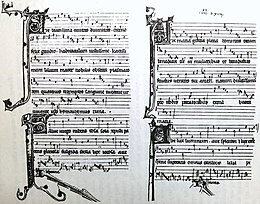
Summary
The Montpellier Codex (Montpellier, Bibliothèque Inter-Universitaire, Section Médecine, H196) is an important source of 13th-century French polyphony. The Codex contains 336 polyphonic works probably composed c. 1250–1300, and was likely compiled c. 1300.[1] It is believed to originate from Paris. It was discovered by musicologist Edmond de Coussemaker in c. 1852.[2][3]

Format and contents edit
The Montpellier Codex can be roughly divided into 8 fascicles, each of which contain discrete genres of music. The format of the Codex is as follows:
- 1. Liturgical polyphony (ff. 1r-22r)
- 2. French triple motets, consisting of a cantus firmus with three contrapuntal lines above it (ff. 23v-61r)
- 3. Macaronic double motets, consisting of a cantus firmus with two contrapuntal lines above it (ff. 63v-86v)
- 4. Latin double motets (ff. 87v-111r)
- 5. French double motets (ff. 111v-227r)
- 6. French two-voice motets (ff. 231r-269v)
- 7 & 8. Three-voice motets, possibly compiled later than fascicles 2-6 (ff. 270r-397v)
There are also supplements added to fascicles 3, 5, and 7. Because of the different systems of notation used in fascicles 2-6 and fascicles 7-8, the Montpellier Codex has become a crucial source for the chronology of styles of French medieval polyphony.
Music edit
The Montpellier Codex is a critical source for what are known as "Pre-Franconian" and "Franconian" motets, after Franco of Cologne. While the music in the Codex is anonymous, a number of attributions can be made, either because of concordances in other manuscripts or on the basis of stylistic similarity, to Pérotin (from fascicle 1), Petrus de Cruce, Adam de la Halle, Guillaume d'Auvergne, and Philippe le Chancelier. Many of the cantus firmi are taken from the chants of Notre Dame. While fascicle 1 consists of sacred polyphony, mostly from the Notre Dame school, the largest body of music in the Codex is the collection of French courtly love motets.
Previously, the motets in the collection were not considered to be isorhythmic, as it was felt that the first isorhythmic motets—those of Philippe de Vitry—were not to be composed until the first decades of the 14th century. Recently, however, Michael Lanford has noted that "of the 148 double and triple motets in fascicles two through five of the Montpellier Codex, 114 have repeating colores." After analyzing several motets, he also demonstrates that "each of Richard Hoppin's 'three isorhythmic procedures' which inform 'future developments of the form' can be found in select tenors from the Old Corpus [of the Montpellier Codex], often in ways that demonstrate resourceful approaches to managing the rhythmic modes." For these reasons, Lanford contends that "by glossing over the presence of isorhythmic techniques in thirteenth-century motets, such as those found in fascicles two through five of the Montpellier Codex, scholars have thus limited the appellation of 'isorhythm' using criteria that is well-reasoned, yet perhaps unnecessarily restrictive."[4]
One motet in the Codex was copied from a polyphonic composition by Willelmus de Winchecumbe (fl. 1270s).[5]
See also edit
Notes edit
- ^ Grove: "Date: fascs.2–6, 1270s (Rosketh and RISM, c1280); fascs.1 and 7, plus the additions to 3 and 5, very end of 13th century (Branner: late 13th century, Everist: 1280s); fasc.8, very early years of the 14th century (Branner and Everist: c1300). As a controversial alternative to the picture of a manuscript compiled in discrete stages of activity a decade or more apart, Wolinski posits a single campaign of copying fascs.1–7 as an entity in the 1260s or 1270s, with fasc.8 perhaps also as early as the 1270s; not widely accepted, her theory has radical implications for the development of the motet, musical notation and music theory in the second half of the 13th century (Wolinski, 1992, pp.299–301)."
- ^ Emil Naumann Illustrierte Musikgeschichte., Volume 2, Spemann, Berlin & Stuttgart 1886.
- ^ Pierre Combe The Restoration of Gregorian Chant: Solesmes and the Vatican Edition, CUA Press, 2008, p. 13f
- ^ "A Reevaluation of Isorhythm in the "Old Corpus" of the Montpellier Codex - College Music Symposium".
- ^ "Wycombe (Wicumbe, ?Whichbury, Winchecumbe), W. de". Retrieved 29 February 2012.(subscription required)
External links edit
- Facsimiles of the codex at the Bibliothèque Interuniversitaire Médecine de Montpellier
- General information and complete index of the codex at the Digital Image Archive of Medieval Music
References edit
- Bradley, Catherine and Karen Desmond. The Montpellier Codex: The Final Fascicle. Contents, Contexts, and Chronologies. Woodbridge, Suffolk: Boydell, 2018.
- Lanford, Michael. (2011). "A Reevaluation of Isorhythm in the "Old Corpus" of the Montpellier Codex." College Music Symposium 51. Retrieved from http://symposium.music.org/index.php?option=com_k2&view=item&id=13:a-reevaluation-of-isorhythm-in-the-old-corpus-of-the-montpellier-codex&Itemid=116
- Parsoneault, Catherine. The Montpellier Codex: Royal Influence and Musical Taste in Late Thirteenth-century Paris (France). Ph.D Diss., U of Texas, 2001
- "Sources, MS, V, 2: Early motet", in Grove Music Online (Accessed October 9, 2006), (subscription access)
- Tischler, Hans. The Montpellier Codex. Madison, Wis. : A-R Editions, 1978. (Critical edition of the codex)
- Wolinski, Mary Elizabeth. The Montpellier Codex. Ph.D Diss., Brandeis University, 1988.


